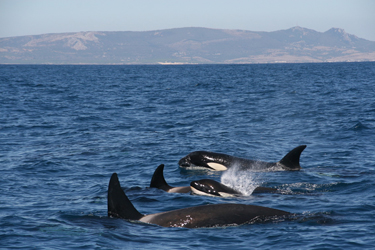A key goal for wildlife managers is identifying discrete, demographically independent conservation units. Previous genetic work assigned killer whales that occur seasonally in the Strait of Gibraltar (SoG) and killer whales sampled off the Canary Islands (CI) to the same population. Here authors present new analyses of photo-identification and individual genotypes to assess the level of contemporary gene flow and migration between study areas, and analyses of biomarkers to assess ecological differences. Mitochondrial DNA control region haplotype was shared by all individuals sampled within each pod, suggesting that pods have a matrifocal social structure typical of this species, whilst the lack of shared mitogenome haplotypes between the CI and SoG individuals suggests that there was little or no female migration between groups. Kinship analysis detected no close kin between CI and SoG individuals, and low to zero contemporary gene flow. Isotopic values and organochlorine pollutant loads also suggest ecological differences between study areas. One individual from a pod within the SoG not seen in association with the other four pods and identified as belonging to a potential migrant lineage by genetic analyses, had intermediate isotopic values and contaminant between the two study areas. Overall results suggest a complex pattern of social and genetic structuring correlated with ecological variation. Consequently at least CI and SoG should be considered as two different management units. Understanding this complexity appears to be an important consideration when monitoring and understanding the viability of these management units which, ultimately, will help the conservation of these threatened management units. informacion[at]ebd.csic.es: Esteban et al (2016) Using a multi-disciplinary approach to identify a critically endangered killer whale management unit. Ecol Indic 66:291-300 doi:10.1016/j.ecolind.2016.01.043
http://www.sciencedirect.com/science/article/pii/S1470160X16000571








 Un estudio analiza la distribución de los mosquitos transmisores de la malaria en España
Un estudio analiza la distribución de los mosquitos transmisores de la malaria en España


